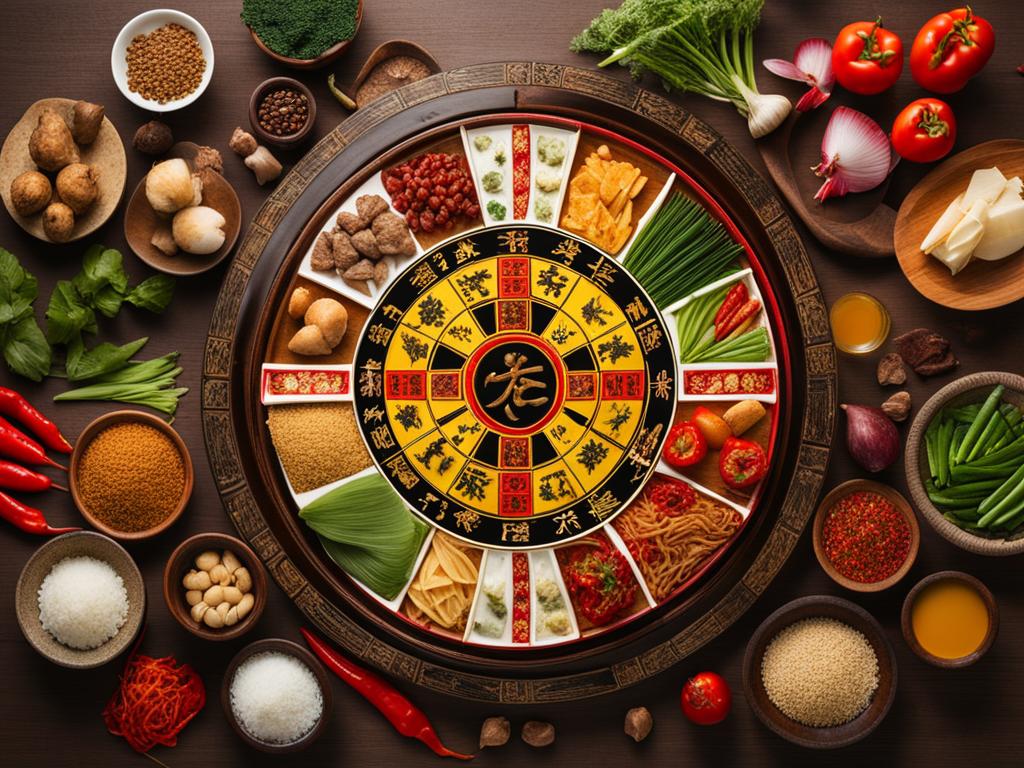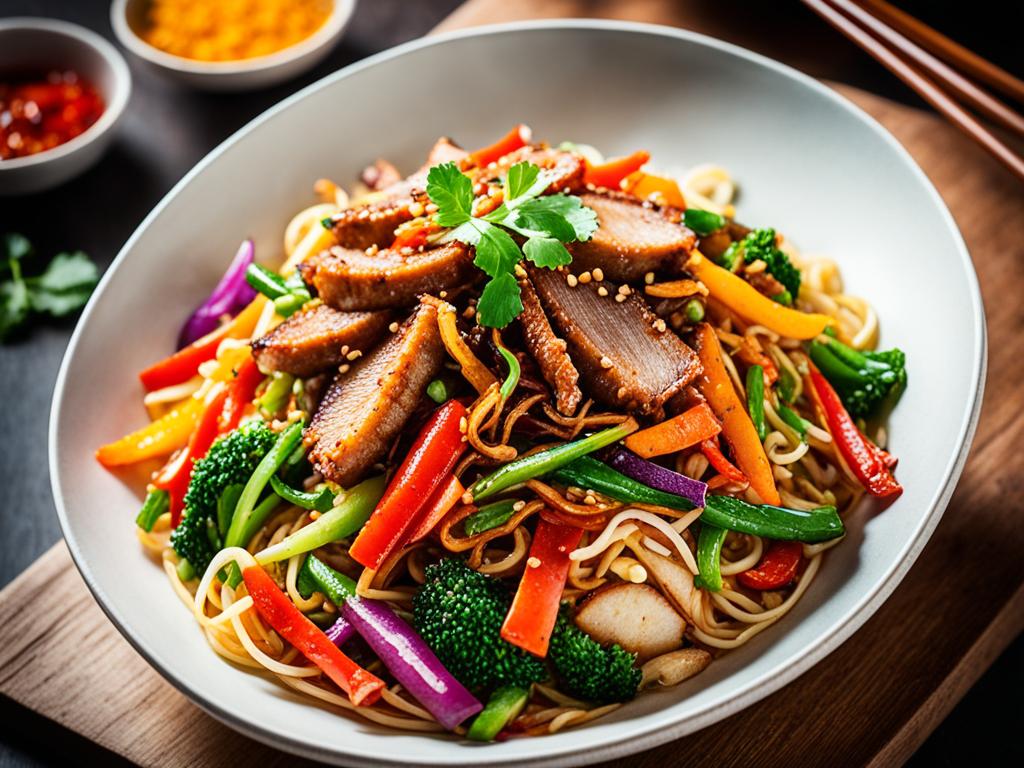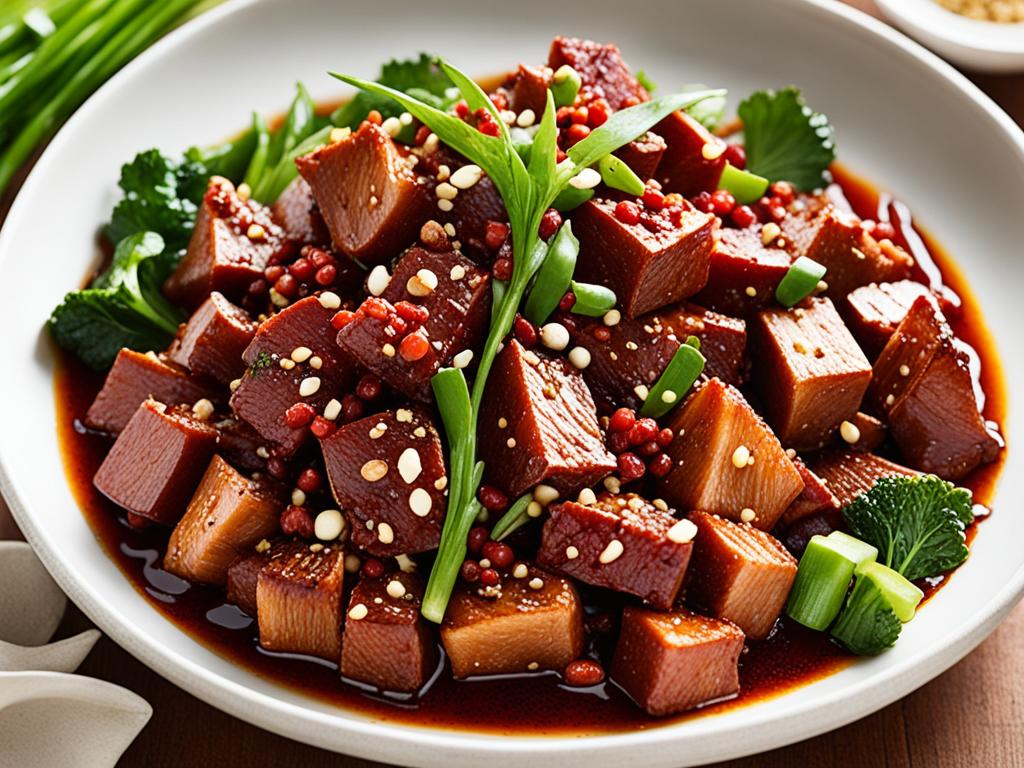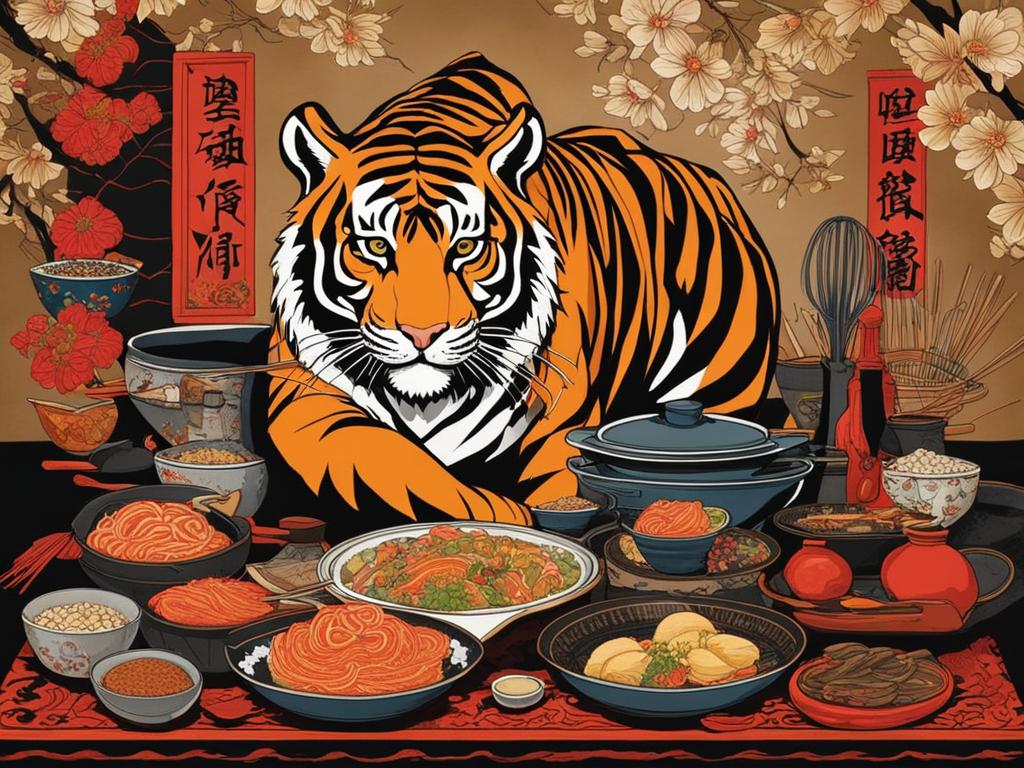Chinese culture has a fascinating connection between astrology and food. The Chinese zodiac, a system that assigns unique animal signs to individuals based on their birth year, plays a significant role in Chinese culinary traditions. Each of the 12 zodiac animals, such as the Rat, Ox, Tiger, Rabbit, Dragon, Snake, Horse, Goat (or Sheep), Monkey, Rooster, Dog, and Pig, have their own associated characteristics and influence on culinary choices. This connection between the zodiac and Chinese cuisine adds a unique and meaningful aspect to the food culture in China.

Key Takeaways:
- The Chinese zodiac influences culinary choices in Chinese cuisine.
- Each zodiac animal has its own associated characteristics.
- The zodiac adds a unique and meaningful aspect to Chinese food culture.
- The Rat, Ox, Tiger, Rabbit, Dragon, Snake, Horse, Goat (or Sheep), Monkey, Rooster, Dog, and Pig are the 12 zodiac animals in Chinese culture.
- The connection between the zodiac and Chinese cuisine shapes flavors and techniques in cooking.
The Rat (鼠): Resourceful and Adaptable
In Chinese culinary traditions, the Rat holds a special place as the first animal in the Chinese zodiac. Known for its resourcefulness and adaptability, the Rat inspires a variety of dishes that symbolize its characteristics. One such dish is the famous Stir-Fried Rat Noodles. Despite the name, it’s important to note that these dishes do not actually contain rats; instead, they use ingredients that represent the Rat’s traits.
The Rat’s resourcefulness is reflected in the efficient use of ingredients in Chinese cooking. Just as the Rat is known for making the most out of any situation, Chinese chefs maximize the flavors and textures of each ingredient, creating harmonious and balanced dishes.
Additionally, the Rat’s adaptability is seen in the diverse flavors and techniques found in different regional cuisines across China. From the fiery spice of Sichuan cuisine to the delicate sweetness of Cantonese dishes, each region showcases its own interpretation of Rat-inspired food.
“The Rat’s resourcefulness and adaptability are deeply ingrained in Chinese culinary traditions. Through innovative ingredient combinations and cooking techniques, Chinese chefs pay tribute to the Rat’s characteristics, creating unforgettable and delicious Rat-inspired dishes.” – First source
Rat-Inspired Ingredients
The Rat’s symbolism is alive in a range of ingredients that represent its resourcefulness and adaptability. Here are some key ingredients commonly used in Rat-inspired dishes:
- Bean sprouts: Symbolizing growth and abundance, bean sprouts add a crisp texture and fresh flavor to Rat-inspired recipes.
- Chinese mushrooms: Known for their versatility and ability to enhance the umami flavor in dishes, Chinese mushrooms reflect the Rat’s adaptability.
- Spring onions: These vibrant green onions represent rebirth and renewal, adding a subtle onion flavor and touch of color to Rat-inspired dishes.
- Soy sauce: A staple in Chinese cooking, soy sauce adds depth and complexity to Rat-inspired dishes, balancing the flavors just as the Rat balances its resourcefulness and adaptability.
Rat-Inspired Recipe: Stir-Fried Rat Noodles
To celebrate the Rat’s resourcefulness and adaptability, try cooking a Rat-inspired dish at home. Here’s a recipe for Stir-Fried Rat Noodles:
| Ingredients | Instructions |
|---|---|
| 1 lb Chinese egg noodles | 1. Bring a pot of water to a boil and cook the noodles according to the package instructions. |
| 1 cup bean sprouts | 2. In a wok or large pan, heat oil over high heat. Add bean sprouts and stir-fry for 2-3 minutes until slightly softened. |
| 1 cup sliced Chinese mushrooms | 3. Add sliced Chinese mushrooms to the wok and continue stir-frying for another 2-3 minutes until mushrooms are tender. |
| 3 spring onions, chopped | 4. Add chopped spring onions to the wok and stir-fry for 1 minute. |
| 2 tablespoons soy sauce | 5. Add soy sauce to the wok and toss the ingredients together until well combined. |
| 1 tablespoon sesame oil | 6. Drizzle sesame oil over the noodles and toss once more. |
| Fresh cilantro leaves for garnish | 7. Serve the Stir-Fried Rat Noodles hot, garnished with fresh cilantro leaves. |
Enjoy this Rat-inspired dish that captures the resourcefulness and adaptability of this fascinating zodiac animal.

The Ox (牛): Strong and Dependable
The Ox, represented by the Chinese character 牛, is known for its remarkable strength and unwavering dependability. In Chinese cuisine, dishes that showcase these traits are often referred to as Ox-inspired dishes. One such dish is the famous Braised Beef Noodles, which perfectly embodies the Ox’s robust qualities.
Beef, being a staple protein source, is commonly used in Chinese cooking to reflect the physical strength of the Ox. The tender and succulent beef in Braised Beef Noodles symbolizes the Ox’s robust and strong nature. It’s a dish that leaves you feeling satisfied and energized, just like the dependable Ox itself.
The Ox’s reliability and dependability can also be seen in the comfort and consistency of Ox-inspired meals. Whether it’s a hearty bowl of Braised Beef Noodles or other flavorful creations, these dishes always deliver a sense of warmth and fulfillment.
Next, let’s delve into another zodiac animal and discover its unique culinary associations!

Braised Beef Noodles Recipe
A traditional recipe for Braised Beef Noodles typically includes the following ingredients:
- Beef (preferably stewing beef)
- Soy sauce
- Rice wine
- Star anise
- Cinnamon
- Garlic
- Ginger
- Scallions
- Chili oil (optional)
- Noodles (such as wheat noodles or rice noodles)
“Braised Beef Noodles is a classic dish in Chinese cuisine, loved for its rich flavors and tender meat. The slow cooking process allows the beef to become incredibly tender, while the aromatic spices infuse the broth with depth. It’s a dish that brings comfort and satisfaction, just like the dependable Ox.”
The Tiger (虎): Brave and Adventurous
The Tiger holds a significant place in Chinese cuisine, symbolizing bravery and adventurousness. This powerful animal is associated with the bold flavors and exciting dishes found in Chinese culinary traditions.
One famous dish that embodies the courage of the Tiger is the “Sichuan Tiger King Prawns.” These succulent prawns are bathed in a fiery Sichuan pepper sauce, creating a sensational explosion of flavors. The intense spiciness reflects the Tiger’s bold nature and adds a thrilling element to the dining experience.
Just like the Tiger’s love for exploration, Chinese cuisine offers a wide array of flavors and regional specialties. From the aromatic spices of Sichuan cuisine to the delicate balance of flavors in Cantonese dishes, there is a world of adventure waiting to be discovered.

Tiger-Inspired Dishes
Here are some other tiger-inspired dishes worth trying:
- Tiger Skin Peppers: A popular Sichuan dish featuring blistered green peppers coated in a spicy sauce.
- Tiger Salad: A refreshing salad with julienned vegetables and a zesty dressing, paying homage to the Tiger’s fearless spirit.
- Tiger Fried Rice: A vibrant and flavorful fried rice dish prepared with exotic spices and colorful ingredients.
These dishes not only showcase the Tiger’s bravery and adventurous nature but also highlight the diverse and exciting flavors found in Chinese cuisine.
The Rabbit (兔): Gentle and Artistic
The Rabbit holds a special place in Chinese cuisine, symbolizing gentleness and artistic sensibility. These qualities are reflected in the delicate and visually stunning Rabbit-inspired dishes that grace Chinese dining tables.
One such dish is the popular Tea-Smoked Rabbit. The tender and succulent meat is infused with the smoky aroma of tea leaves, creating a harmonious blend of flavors. The meticulous preparation of this dish showcases the gentle and artistic nature associated with the Rabbit.
Additionally, during the Mid-Autumn Festival, rabbit-shaped mooncakes are a delightful treat that exemplify the Rabbit’s fondness for beauty and creativity. These intricately designed pastries not only please the palate but also captivate the eye, demonstrating the Rabbit’s artistic sensibilities.

Tea-Smoked Rabbit Recipe:
- Marinate the rabbit meat with a blend of soy sauce, honey, and aromatic spices.
- Prepare the smoking mixture by combining tea leaves, rice, and brown sugar.
- Smoke the marinated rabbit meat over low heat for several hours, allowing the flavors to infuse.
- Gently roast the smoked rabbit to achieve a perfectly crispy exterior.
- Serve the Tea-Smoked Rabbit with steamed rice and seasonal vegetables for a delightful culinary experience.
Experience the gentle elegance of the Rabbit in Chinese cuisine with these exquisite dishes that celebrate the artistry and sophistication of this zodiac sign.
The Dragon (龙): Energetic and Charismatic
The Dragon holds great significance in Chinese cuisine, representing energy and charisma. One iconic dish that embodies the vibrancy and allure of the Dragon is “Dragon Well Shrimp.” This dish tantalizes the taste buds with its lively flavors and captivates the eyes with its captivating presentation. The Dragon’s energetic and charismatic qualities are reflected in the vibrant colors, bold spices, and dynamic cooking techniques used in dragon-inspired dishes.
The Dragon is considered a symbol of good fortune, making it a popular motif during festivals. Dragon-themed desserts and pastries, often intricately designed, are a common sight, adding an auspicious touch to celebratory meals. This culinary tribute to the Dragon not only delights the palate but also brings blessings of luck and prosperity.
Embrace the essence of the Dragon in Chinese cuisine and indulge in the flavors and symbolism it offers. Let its energy and charisma ignite your culinary adventures and bring joy to your dining experiences.
Conclusion
The Chinese zodiac holds a significant place in Chinese culinary traditions, enriching the food culture in China. Each of the 12 zodiac animals, from the resourceful Rat to the strong Ox, the brave Tiger to the gentle Rabbit, and the energetic Dragon to the charismatic Snake, influences culinary choices and techniques. The characteristics associated with each animal shape the flavors, ingredients, and cooking methods used in Chinese cuisine, resulting in a diverse and vibrant culinary landscape.
Moreover, the connection between the Chinese zodiac and Chinese cuisine inspires unique dishes and food traditions, reflecting the deep-rooted cultural heritage of China. Zodiac-inspired food signifies a blend of astrology and culinary practices, allowing individuals to experience the symbolism and essence of each animal through food. By understanding the significance of the zodiac animals in Chinese cooking, one gains a deeper appreciation for the beliefs and traditions that have shaped Chinese cuisine over centuries.
Chinese Zodiac-inspired food traditions in China not only provide nourishment but also serve as a way to celebrate cultural identity and express ancestral beliefs. This interplay between astrology and traditional cooking techniques creates a tapestry of flavors, textures, and aromas that captivate the senses and evoke a sense of cultural pride.
FAQ
How does the Chinese zodiac influence Chinese culinary traditions?
The Chinese zodiac plays a significant role in Chinese culinary traditions. Each of the 12 zodiac animals has its own associated characteristics and influences on culinary choices. From resourcefulness and adaptability to strength and dependability, these traits shape the flavors and techniques used in Chinese cooking. The zodiac also inspires unique dishes and food traditions, creating a harmonious blend of astrology and culinary practices.
What are some examples of Zodiac-inspired Chinese dishes?
Some examples of Zodiac-inspired Chinese dishes include “Stir-Fried Rat Noodles” symbolizing the resourcefulness and adaptability of the Rat, “Braised Beef Noodles” representing the strength and dependability of the Ox, and “Sichuan Tiger King Prawns” embodying the bravery and adventurousness of the Tiger. Other dishes include “Tea-Smoked Rabbit” reflecting the gentleness and artistic sensibility of the Rabbit and “Dragon Well Shrimp” showcasing the energy and charisma of the Dragon.
Are these dishes made with actual animals mentioned in the Chinese zodiac?
No, these dishes are not made with actual animals mentioned in the Chinese zodiac. Instead, they use ingredients that symbolize the characteristics associated with each zodiac animal. For example, “Stir-Fried Rat Noodles” represent the Rat’s resourcefulness and adaptability through the efficient use of ingredients, and “Braised Beef Noodles” symbolize the strength and dependability of the Ox through the use of beef as a staple protein source.
How do Chinese culinary traditions reflect the characteristics of each zodiac animal?
Chinese culinary traditions reflect the characteristics of each zodiac animal through the selection of ingredients, flavors, and cooking techniques. For example, dishes associated with the Rat are resourceful and adaptable, often incorporating a variety of ingredients and flavors. Ox-inspired dishes are hearty and satisfying, reflecting the Ox’s strength and dependability. Tiger-inspired dishes are bold and spicy, mirroring the Tiger’s bravery and adventurous nature. Rabbit-inspired dishes are delicate and artfully presented, showcasing the Rabbit’s gentleness and artistic sensibility. Dragon-inspired dishes are vibrant and visually appealing, capturing the energy and charisma of the Dragon.
How can knowing about the Chinese zodiac enhance one’s understanding of Chinese cuisine?
Understanding the connection between the Chinese zodiac and Chinese cuisine provides valuable insights into the rich cultural heritage of China and its culinary traditions. It allows individuals to appreciate the symbolism and meaning behind certain dishes and food traditions. By aligning their own zodiac sign with specific flavors and ingredients, individuals can also explore personalized food pairings based on their astrological associations. Additionally, knowing about the Chinese zodiac in the context of Chinese cuisine fosters a deeper appreciation for the diversity and nuances of regional cuisines throughout China.





